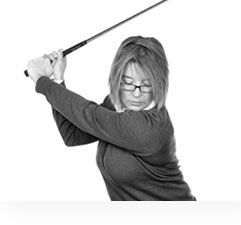 Natalie Adams – PGA Teaching Pro
Natalie Adams – PGA Teaching Pro
A fat shot in golf just simply means that the club head has struck the ground before it struck the golf ball. So you have hit the ground and then the ball and that’s producing a fat shot, a fat strike. So as you are swinging the club back, the club is coming in and striking the ground way before the ball and the effect of that is, that the club is going to have all the speed taken out of the club head, so you are not going to hit the ball very far. If the ground conditions are quite soft, the club head is going to dig in to the turf and you are going to stay low to the turf than the ball, not moving it very far, because the turf has taken the club head speed. And if the ground conditions were a little bit firmer, you are going to bounce the club off the ground and you are going to catch the ball onto your upswing.
So you are going to end up topping to the shot, hitting in and bouncing up. But a fat shot really, you are looking at soft ground conditions, the club head struck the ground too early and so you have dug into the turf. And there is many reasons these can happen. But this is a great tip and drill for you to try to encourage you to strike the ball cleaner rather than catching the ground first. So if we know that what's causing the fat shot is that the club is grounding and reaches the lowest points too early before the ball, than what we are going to do is take a head cover or you could use a towel that’s folded up, just something with a little bit of height, a few inches of height and we are going to place that onto the target line, so it’s in line with the ball and where you want to hit the ball to, and then we are going to take your stance up. So we should see that the object that we have put in there, in this case the head cover is opposite of the outside of your right shoe.
We are just going to move the ball out initially and what we need to do is take a really good setup position, so very balanced, nice wide stance, but just hover the golf club up a little bit higher than you usually would. This will allow you to swing the club bat without actually hitting that head cover, because we don’t want to move it out of the way, we need it for the downswing. And what we need to do now is work on bringing the club back down, so that the club head travels down, misses the head cover and then strikes the ground on the left of that head cover, where the golf ball would be. So take the ball out, and start to work on that, hover the club head and strike the ground where the ball would be. And then work on improving the speed of that movement, until you have got up to a more realistic swing speed, that you would actually hit a golf ball with. And once you are able to do that, you are feeling confident and successful with there drill, then replace the ball back in and strike the ball without striking the head cover.
But again, if you do strike the head cover, don’t see that as you failed at it, look at its feedback to give you the opportunity to learn, so that you can improve your learn from that situation. You have started to drop the club head a little bit too early and it’s making you hit the ground before the ball. So just go back to playing the shot without the ball in, get yourself comfortable again, that you are striking the ground in the correct position without hitting that head cover and then put the ball back in. And just work on building your speed up until you are feeling a lot more successful. Hover the club and strike through, that will really allow you to strike the ball crisply, you are connecting with the ground in the correct place of where the ball is and you won’t be hitting any more of fat shots.





